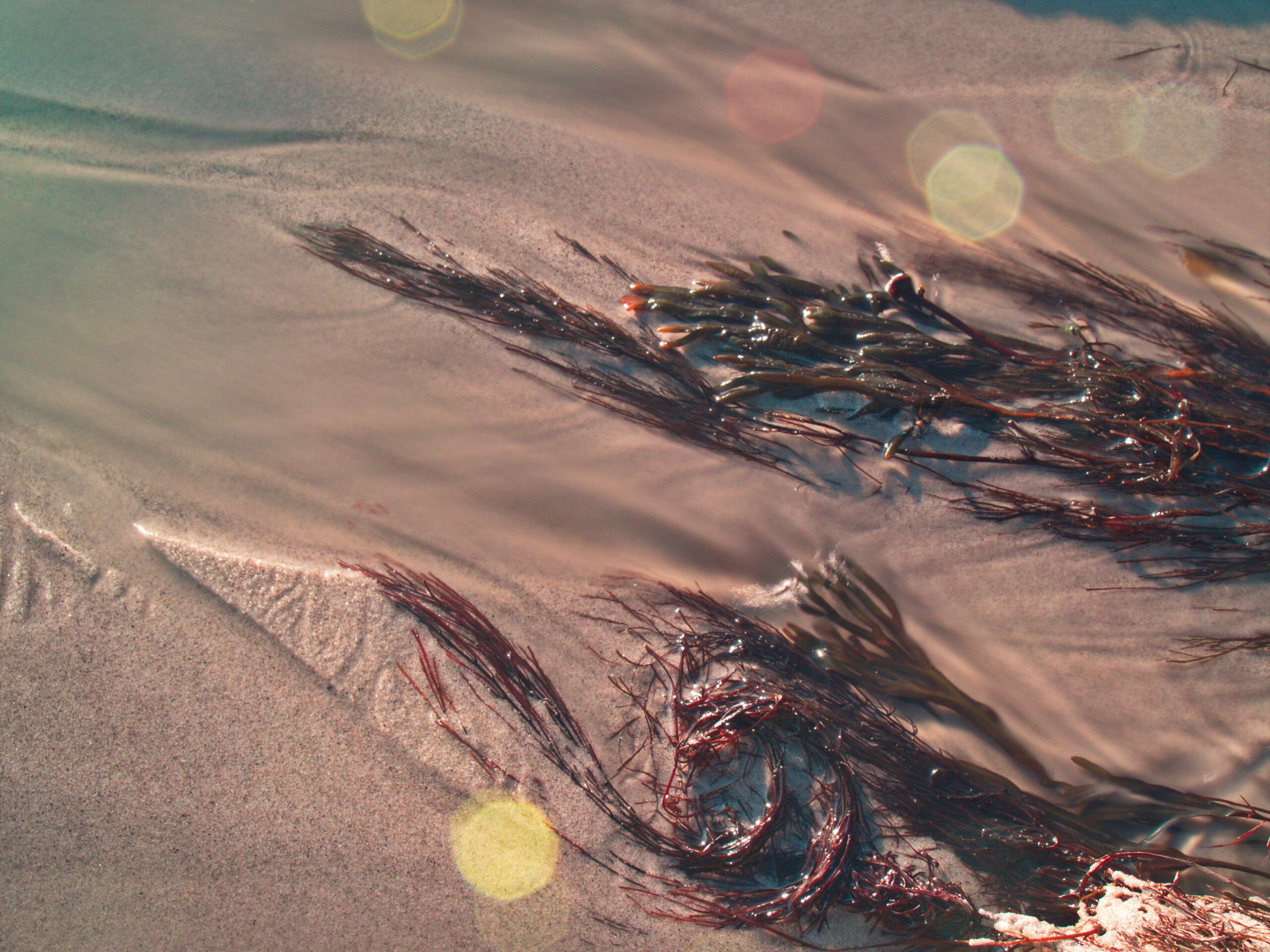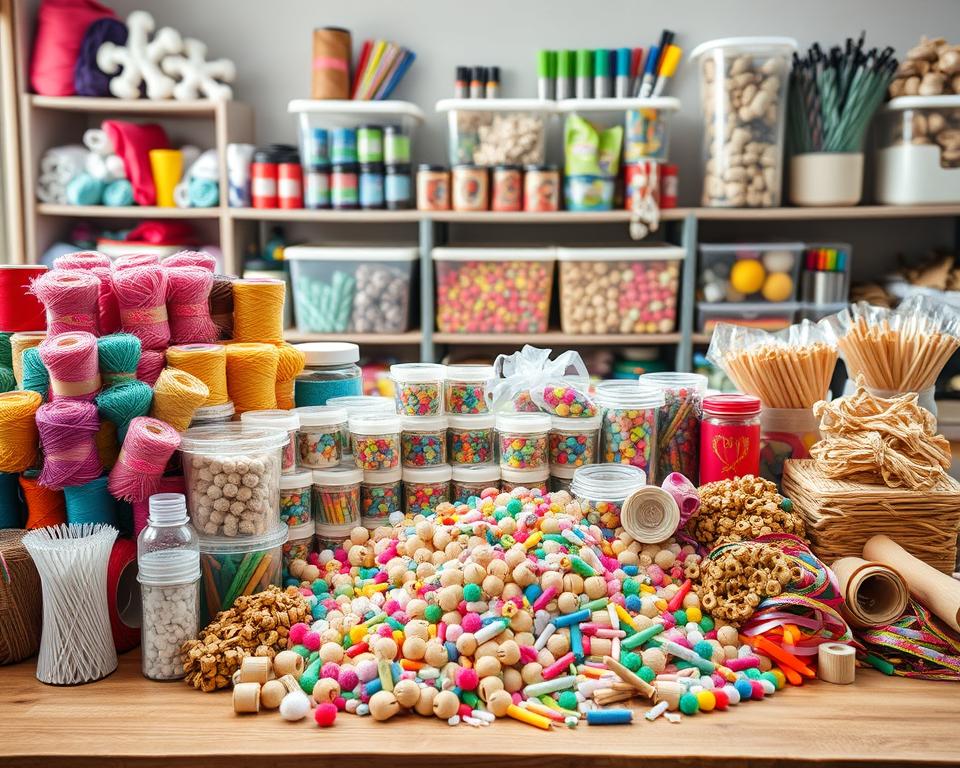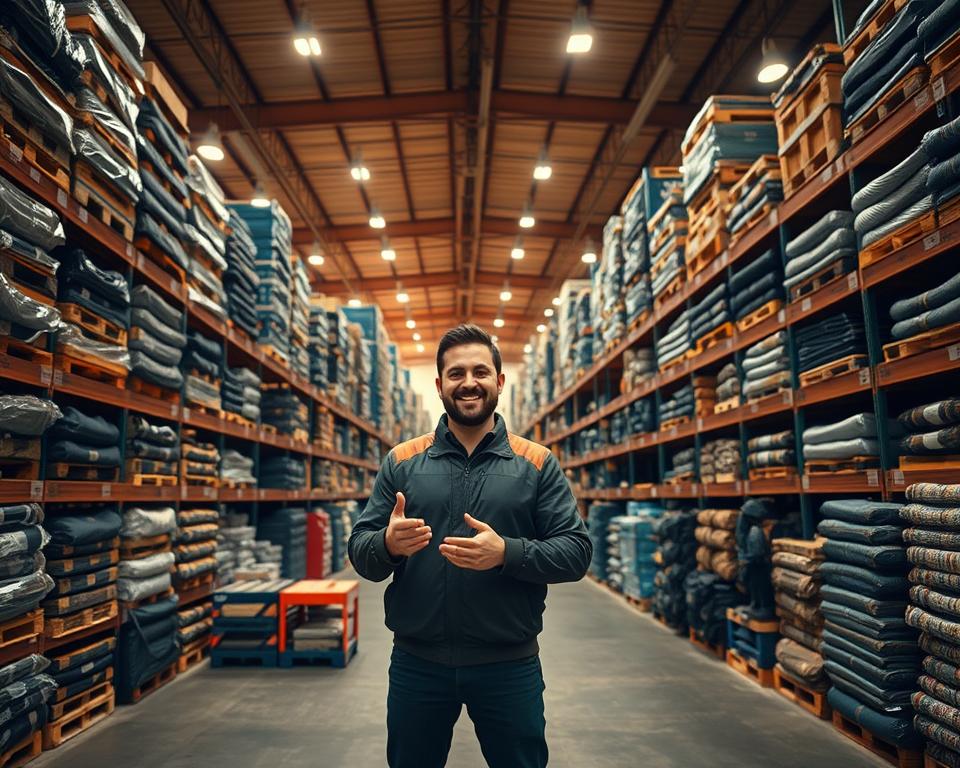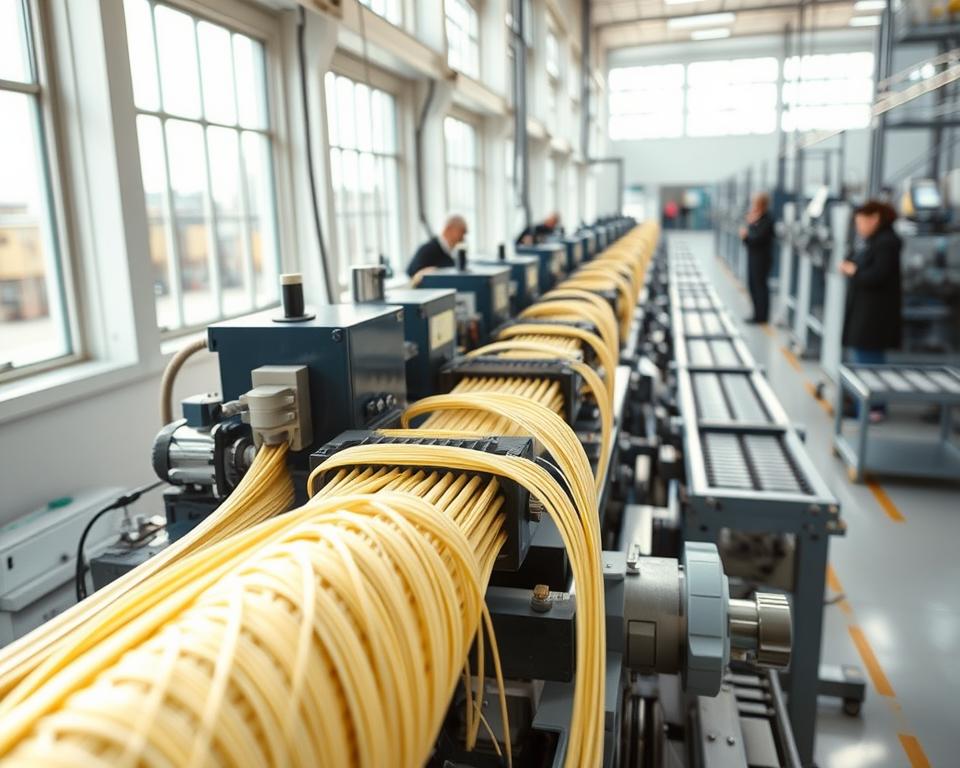Premier Self-edge Jean Material Manufacturers Handbook
Are you aware that selvedge denim, famous for its toughness and everlasting allure, is crafted by talented craftsmen? The process of selvedge denim begins with the textile producers who carefully weave and construct this notable jean material. Finding the right self-edge denim material producers is crucial to ensuring the superior craftsmanship and artistry in your jeans.
If you’re on the hunt for the best self-edge denim, search no more. In this comprehensive handbook, we’ll guide you through the top self-edge denim textile producers, revealing the names that are known for their devotion to quality and exactness. From Iron Heart and Samurai to PBJ and Oldblue Co., we’ll examine the top names that epitomize the core of selvedge denim by the yard.
But first, let’s uncover the fundamentals of self-edge denim and grasp why it has charmed denim enthusiasts and fashion connoisseurs alike. Discover the skill, legacy, and special characteristics that make Japanese-made, American-made, and European-made self-edge denim truly exceptional. From the weaving process to the different weights and features, we’ll explain the selvage range and equip you with the insight to make an informed choice.
So, whether you’re a jean expert or new to your journey into the realm of selvedge denim, this handbook will be your dependable resource in investigating the best selvedge denim fabric manufacturers and learning about the essence of this everlasting textile. Let’s begin this denim exploration collectively and find out the best that selvedge denim has to give.
Selvedge Denim Essentials: Understanding the Basics
Self-edge denim is a cornerstone of superior artistry and everlasting appeal. But what exactly is selvedge denim, and what sets it apart from its counterparts? In this part, we will examine the essentials of self-edge denim, explaining its distinctive features and why it has gained such a loyal fanbase.
Selvedge denim is a kind of denim textile crafted on old-fashioned shuttle weaving machines, which make a sealed edge on both sides of the material. This sealed edge, marked by the iconic colored lines running along the outer of the edge, prevents fraying edges and unraveling, creating a neater, stronger material. This careful focus on detail in the fabrication technique makes self-edge denim greatly desired by denim enthusiasts.
One of the distinguishing characteristics of selvedge denim is its association with premium quality and heavier weight fabric. Makers, particularly those in Japanese, are renowned for their proficiency of selvage denim creation, using long staple cotton fibers and age-old practices to craft denim that is not only long-lasting but also possesses a textured richness and character depth.
Grasping selvage denim fundamentals is crucial to recognizing the distinctiveness of this fabric. The next part will explore the legendary Japanese textile mills responsible for creating some of the finest selvedge denim in the globe.
Legacy and Artistry: Japanese Selvedge Demystified
This part delves into the rich heritage and unmatched artistry behind Japanese self-edge denim. Japan has long been synonymous with outstanding denim production, and its weaving factories have achieved fame in the field. Let’s explore some of these renowned mills and uncover the unique traits that make Japanese denim truly exceptional.
Legendary Japanese Mills
Japanese selvage owes its reputation for quality to the skill and devotion of its textile mills. Some of the most revered names in the market are:
| Factory | Region |
|---|---|
| Amhot Textile Mill | Okayama |
| Kuroki Weaving Factory | Yamagata |
| Japan Blue/Collect Mills | Kojima Region |
| Kaihara Weaving Factory | Hiroshima |
| Nihon Menpu Mills | Tokyo |
| Toyoshima Textile Mill | Chiba Region |
These textile mills have established themselves as pioneers in producing some of the best self-edge denim in the world. Each factory contributes its distinctive style and artistry to the denim creation process, creating a wide array of options for denim fans.
Distinctive Qualities of Japanese Denim
Japanese self-edge denim is admired for its outstanding craftsmanship and distinctive characteristics. Here are some of the main traits that set Japanese-made denim apart:
- Premium Quality: Japanese mills take immense pride in employing the highest quality materials and utilizing traditional techniques to produce jeans with unequalled strength and wearability.
- Heavier Weight Fabric: Denim from Japan is often crafted using thicker textiles, renowned for their robustness and ability to produce gorgeous wear patterns over time.
- Reputation for Excellence: Japanese-made denim is commonly seen as the epitome of premium denim fabric, wanted by denim aficionados around the world.
These distinctive traits render Japanese selvedge denim a preferred option among denim fans and aficionados who recognize the craftsmanship and skill that goes into creating each denim pair.
Discovering American Selvedge: Iconic Mills and Their Histories
When it comes to American selvedge denim, there are a few renowned textile mills that have made a significant impact on the industry. One of the most famous is Cone Mills, which is notable as being the last selvedge denim mill in the USA.
Cone Textile Mill has a storied past, tracing its roots to the year 1891, and its association with Levi’s Jeans has been important in the acceptance of denim from the US. The high-quality fabric created by Cone Mills has been employed in Levi’s denim for generations, making it linked to US denim history.
Aside from Cone Mills, there are other renowned American rainbow selvedge denim textile mills that have helped to the field development and renown. The White Oak Branch, a section of Cone Textile Mill, was well-known for its premium denim before its ending in the year 2017. Another notable mill is Rogue Territory, which has become known for its skill and dedication to making top-tier denim.
Choosing premium raw selvedge denim from these American mills gives several perks. The longevity of the textile ensures that your denim wear will endure extended wear and numerous washes. Additionally, the one-of-a-kind color changes that form over time produce a individualized and original appearance, making each pair of jeans original. With American self-edge denim, you receive excellent value for your money.
| Mills | Year Founded | Key Achievements |
|---|---|---|
| Cone Textile Mill | 1891 | Source of fabric for Levi’s garments |
| White Oak Division (Cone Mills) | 1905 | Famous for superior fabric before 2017 shutdown |
| Rogue Territory Mills | the early 21st century | Famed for skill and top-tier denim |
Exploring European Excellence in Denim Fabrication
European self-edge denim is famous for its exceptional craftsmanship and superiority. In this section, we focus on two Italian experts of denim creation: Candiani Textile Mill and Berto Textile Mill. These mills have built a strong renown in the industry for their superior denim fabric.
Italian Experts: Candiani and Berto Mills
Candiani Textile Mill, located in Italy, has been producing some of the finest denim textile since the year 1938. With a devotion to environmental responsibility, Candiani Textile Mill employs advanced techniques and green practices to produce premium denim that meets the best standards.
- Their textiles are renowned for their softness, toughness, and beautiful color changes.
- The European self-edge denim from Candiani is chosen by trendsetting labels and jean connoisseurs alike.
- They have a wide range of jean choices, from lightweight to heavyweight, making possible adaptability in assorted garment styles.
Berto Weaving Factory, another famed Italian textile mill, has been at the forefront of denim production for over 120 years. With a profound tradition and devotion to traditional craftsmanship, Berto Mills keeps to produce top-tier denim textile that aligns with the top requirements.
- The European self-edge denim from Berto is famous for its special characteristics, with slubby textures and gorgeous wear patterns.
- Berto Mills has a diverse range of jean thicknesses and surface treatments, enabling designers and denim enthusiasts to produce distinctive and one-of-a-kind items.
- They focus on green manufacturing approaches and utilize natural and repurposed substances to reduce the environmental impact of denim creation.
Contributions from Cone Mills: The US Denim Heritage
While exploring European mastery, it’s vital to acknowledge the legacy of Cone Mills, an iconic American denim mill, to European jean history. Cone Textile Mill has been a pioneer in the jean market for more than a hundred years, well-known for its commitment to superiority and creativity.
- The self-edge textiles from Cone Mills have been employed by renowned denim brands around the world, demonstrating the flexibility and strength of US-made jeans.
- Cone Mills’ selvage choices include a wide range of designs, weights, and treatments, serving the diverse needs of style creators and denim enthusiasts.
- From traditional blue denim to contemporary flexible types, Cone Mills keeps to push the boundaries of denim creation.
European selvage denim lovers are have a wealth of options with the exceptional offerings from Candiani Textile Mill, Berto Weaving Factory, and the history of Cone Mills. These textile mills embody the zenith of craftsmanship and showcase the devotion to superiority that has made European self-edge textiles in high demand in the style market.
The Selvedge Denim Fabric Manufacturers
In the world of self-edge denim, a wide range of manufacturers contribute to the making of this superior material. Each manufacturer contributes its own style, resulting in a wide array of selvedge denim brands. Discovering various producers is vital in locating the ideal pair of self-edge jeans that suit personal tastes.
Below is a complete compilation of selvedge denim fabric manufacturers known for their top-tier production and skill:
| Manufacturer |
|---|
| Ironheart |
| Samurai |
| Oni |
| Pure Blue Japan |
| Flat Head Jeans |
| Fullcount Denim |
| Benzak |
| Indigofera |
| Blaumann Jeanshosen |
| Ooe Yofukuten & Co. |
| Oldblue |
These makers have established themselves as leaders in the selvedge denim industry. Each label has its individual flair, cut, and fabric composition, serving diverse preferences.
Whether you’re a hardcore jean lover or a fashion-forward individual, it’s vital to discover the choices from different self-edge textile producers to find the perfect pair of denim that resonate with your personal style.
The Art of Denim Weaving: The Making of Self-edge
Denim fabrication is a meticulous craft that is crucial in the production of selvedge fabric. The complex knitting method requires the crossing of threads to create the distinctive slanting design that jeans is recognized by.
Shuttle Looms vs. Projectile Looms
Two kinds of looms are commonly used in jean knitting: loom shuttles and modern weaving machines. Loom shuttles are vintage, more deliberate devices that make selvedge denim. These looms include a loom carriage that moves the filling yarn through the warp threads. The produced textile has a closed edge, referred to as the selvage, which stops unraveling and demonstrates the skill of the fabrication technique.
On the other hand, modern weaving machines are contemporary, quick devices that are widely used in high-volume making. These looms shoot the filling yarn across the warp threads using a rapier or compressed air device. While modern weaving machines are efficient for mass jean making, they do not create selvedge denim shirt mens owing to their lack of closed-edge creation.
The Importance of Unwashed Denim in Self-edge Making
Unwashed denim, also referred to as natural or uncleaned denim, is vital in the creation of selvage material. Untreated denim is crafted from cotton yarns that have not experienced any pre-treatment or treatments, keeping the original traits of the material.
When untreated denim is woven on loom shuttles, it creates a sturdy and dense fabric with a closer knit. The lack of pre-treatment enables the jeans to create unique fades and creases as they age, leading to a unique and individualized appearance. This is why fans of untreated self-edge appreciate the superior and longevity of selvedge jeans.
The blend of shuttle looms and raw denim demonstrates the traditional artistry and focus on precision that goes into producing selvage material. Each pair of selvedge jeans narrates a tale through its knitted build and raw texture, making them a preferred option among jean experts.
Understanding the Self-edge Range: Types and Attributes
In the universe of selvage, types and attributes play a significant role in the distinctiveness of the textile. Selvedge denim fabrics are available in a range of thicknesses, and each class has its special features and advantages.
A main point to take into account when learning about selvedge denim is the thickness of the material. Selvage material classes can vary, and heavier weights are usually linked to strength and longevity. These fabrics have a denser weave and are less prone to wear and tear, making them ideal for those looking for a durable and sturdy denim pair.
Alongside densities, selvedge denim also provides a diverse selection of traits that enhance its attraction. One of these qualities is slubbiness, which refers to the irregular thickness or fine threads employed in the fabric. Slubby selvedge denim has a textured and uneven appearance, adding an element of uniqueness and appealing appearance.
Texture is another key trait of selvedge denim. According to the knitting method employed and the variety of fibers, selvedge denim can have a rough or soft surface. The feel of the fabric affects the general appearance and comfort of the wear, producing a special handling feel.
Color changeability is another feature to consider when discovering selvedge denim. Certain types of selvedge denim are renowned for their outstanding color changes, enabling the textile to display use and create distinct designs with age. This characteristic adds to the personalized nature of selvage materials and the tale it narrates through its appearance.
Overall, the selvedge spectrum encompasses a wide range of thicknesses and qualities, permitting individuals to choose the material that is most suitable for their tastes and desired wearing experience. Whether wanting strength, surface, or color changes, selvage materials has a wide array of selections to learn about.
Crucial Aspects to Evaluate in Selvage Denim
When it comes to selecting the perfect pair of self-edge jeans, considering important traits can be crucial. Two vital elements to think about are textile density and durability.
Textile Density and Toughness
Textile density affects the density and durability of the denim material, influencing its durability and wearability. Denser selvage denim, usually between 14 to 21 ounces, is typically stronger and resistant to wear and tear, making it an suitable selection for individuals wanting denim that can endure tough conditions and give durable comfort.
The toughness of selvedge denim is improved by the tightly woven construction of the fabric. The employment of vintage weaving machines produces a closer interlacing, leading to a tougher textile that can resist repeated washes and daily wear.
For those who prefer a lighter weight option, selvedge denim with a less dense textile, between 10 to 13 ounces, offers a softer and airier wear. While thinner jeans may not be as tough as thicker choices, it still has a good amount of toughness and can develop one-of-a-kind color changes and individuality over time.
Fade Potential and Textile Character
One of the hallmarks of selvedge denim is its ability to develop individual color changes that reveal the user’s habits and habits. Wear pattern formation means the material’s inclination to age and create one-of-a-kind looks and shade differences with repeated wear and washing.
Material attributes is another key feature to consider when selecting selvedge denim. This indicates the distinctive visual traits, such as roughness, rope-like texture, and uneven knitting. These traits add to the individuality of the material and can turn each denim pair truly one-of-a-kind.
Whether you want a softer and even wear pattern or a dramatic and pronounced look, comprehending the wear pattern formation and fabric traits of self-edge jeans can assist you choose a fabric that fits your individual taste and preferred appearance.
Fabric Weight and Durability
| Fabric Weight | Toughness |
|---|---|
| Heavyweight (14-21 ounces) | Strong, suitable for hard wear |
| Thin (10-13 oz) | Good durability with a cooler comfort |
Sustainability in Selvedge: Eco-Friendly Manufacturing Approaches
In the universe of selvage denim, sustainability has become an growing concern of eco-friendly manufacturing. Shoppers are now more aware of the environmental impact of the goods they acquire, and the jean market is no outlier. To tackle these issues, weaving factories like Candiani Mills have emerged as leaders of eco-friendly self-edge making.
Candiani Mills, known as the most eco-friendly weaving factory in the market, is focused on using eco-friendly manufacturing approaches. The weaving factory prioritizes minimizing water use, reducing chemical use, and incorporating innovative technologies to reach a eco-friendlier manufacturing approach. By employing these methods, Candiani Mills works to make denim that more than aligns with superior benchmarks but also matches the values of conscious consumers.
It is crucial for shoppers to make informed choices and back labels and producers that value environmental responsibility. By choosing eco-friendly self-edge jeans, individuals can help with a greener jean market. Together, we can promote the use of green methods throughout the production process and promote a eco-friendlier era for jean making.
| Benefits of Sustainable Selvedge Denim |
|---|
| 1. Lower water usage |
| 2. Reduced chemical use |
| 3. Minimized planetary burden |
| 4. Promotes responsible creation |
| 5. Aligns with conscious consumer values |
Denim Innovations: Blending Tradition with Technology
This segment of the piece examines the fascinating realm of jean advancements that seamlessly blend heritage with modern technology. Jeans, a everlasting and adored textile, has continued to evolve to fit the requirements of current trends while remaining faithful to its history.
Contemporary Improvements in Jean Fabrics
With progress in fabric techniques, denim manufacturers have been able to enhance the performance and durability of their fabrics. Cutting-edge knitting methods, such as the employment of shuttle weaving machines, make a denser, more compact interlacing that results in a more durable and robust material. This not just improves the longevity of the fabric but also enhances top-tier color changes and special surface.
Textile techniques have also been crucial in improving denim material. Unique methods, such as enzyme washes and surface treatments, can make a diverse selection of styles, from weathered and vintage styles to smooth and shiny finishes. These processes enable adaptability to traditional denim, allowing for a wider range of style options and buyer tastes.
Advances in Eco-Friendly Practices
In addition to contemporary improvements in denim material, the industry has made significant breakthroughs in green manufacturing. Realizing the necessity to lessen its burden on the planet, jean makers have been investigating green coloring techniques and embracing the use of recycled materials.
By employing green coloring methods, such as bubble dyeing or natural blue pigment, makers are reducing water and energy consumption while still creating bright and long-lasting jeans. The employment of reused substances, such as repurposed threads or plastic yarns, helps reduce the demand for new resources and redirects fabric scraps from dumps.
This dedication to environmental sustainability secures that denim production can continue to thrive without harming the condition of the environment. As the field progresses, employing both old-fashioned skill and cutting-edge technology, a eco-friendlier and conscious way to jean making will turn into the standard.
Current Advancements and Green Manufacturing in Denim
| Current Advancements | Environmental Sustainability |
|---|---|
| Cutting-edge knitting methods | Eco-friendly color applications |
| Material processes | Use of recycled materials |
The chart above the article demonstrates the contemporary improvements in denim textiles and the corresponding breakthroughs in green manufacturing. It demonstrates the persistent attempts of the industry to merge heritage and modernity with green techniques, securing a better and eco-friendlier era for denim.
Final Thoughts
After delving into the world of self-edge textile producers, it is obvious that there is a vast range of choices available to jean lovers. From renowned brands like Iron Heart, Samurai, and Oni to The Flat Head, Full Count, and Indigofera Prima Jeans, each producer adds their individual flair and craftsmanship to the industry. When it comes to selecting the perfect maker, it is vital to think about personal tastes and the desired look and feel of the denim material.
In addition to the wide range of producers, the perks of premium raw selvedge denim cannot be ignored. Its long-lasting nature, better fades, and great bang for your buck make it a worthwhile investment for denim fans. Moreover, eco-friendliness plays a significant role in the denim industry, and many producers are employing green methods to manufacturing, such as Candiani Textile Mill, known as the leading green textile mill in the market.
Lastly, the jean market persistently changes by combining history with innovation. Current advancements in denim textiles, such as advanced weaving techniques and material processes, enhance the functionality and strength of selvage denim. Advances in eco-friendly practices, such as sustainable color applications and the employment of reused components, contribute to a eco-friendlier jean market.
In conclusion, learning about the world of selvage material makers offers a variety of choices and enables individuals to locate the ideal pair of denim that align with their personal tastes. From the perks of premium raw selvedge denim to eco-friendly production and denim innovations, there is a lot to explore and appreciate in the realm of selvedge denim. So, spend a moment to research and make informed choices to enjoy the everlasting appeal and quality of self-edge jeans.



